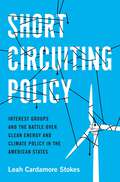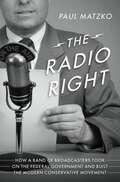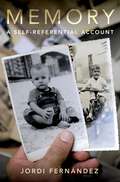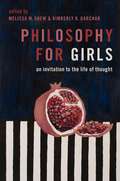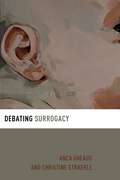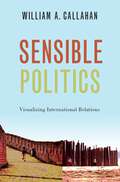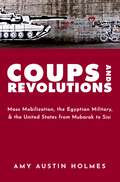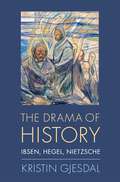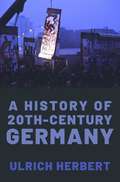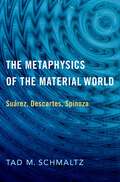- Table View
- List View
Short Circuiting Policy: Interest Groups and the Battle Over Clean Energy and Climate Policy in the American States (Studies in Postwar American Political Development)
by Leah Cardamore StokesIn 1999, Texas passed a landmark clean energy law, beginning a groundswell of new policies that promised to make the US a world leader in renewable energy. As Leah Stokes shows in Short Circuiting Policy, however, that policy did not lead to momentum in Texas, which failed to implement its solar laws or clean up its electricity system. Examining clean energy laws in Texas, Kansas, Arizona, and Ohio over a thirty-year time frame, Stokes argues that organized combat between advocate and opponent interest groups is central to explaining why states are not on track to address the climate crisis. She tells the political history of our energy institutions, explaining how fossil fuel companies and electric utilities have promoted climate denial and delay. Stokes further explains the limits of policy feedback theory, showing the ways that interest groups drive retrenchment through lobbying, public opinion, political parties and the courts. More than a history of renewable energy policy in modern America, Short Circuiting Policy offers a bold new argument about how the policy process works, and why seeming victories can turn into losses when the opposition has enough resources to roll back laws.
On Borders: Territories, Legitimacy, and the Rights of Place
by Paulina Ochoa EspejoWhen are borders justified? Who has a right to control them? Where should they be drawn? Today people think of borders as an island's shores. Just as beaches delimit a castaway's realm, so borders define the edges of a territory, occupied by a unified people, to whom the land legitimately belongs. Hence a territory is legitimate only if it belongs to a people unified by a civic identity. Sadly, this Desert Island Model of territorial politics forces us to choose. If we want territories, then we can either have democratic legitimacy, or inclusion of different civic identities--but not both. The resulting politics creates mass xenophobia, migrant-bashing, hoarding of natural resources, and border walls. To escape all this, On Borders presents an alternative model. Drawing on an intellectual tradition concerned with how land and climate shape institutions, it argues that we should not see territories as pieces of property owned by identity groups. Instead, we should see them as watersheds: as interconnected systems where institutions, people, the biota, and the land together create overlapping civic duties and relations, what the book calls place-specific duties. This Watershed Model argues that borders are justified when they allow us to fulfill those duties; that border-control rights spring from internationally-agreed conventions--not from internal legitimacy; that borders should be governed cooperatively by the neighboring states and the states system; and that border redrawing should be done with environmental conservation in mind. The book explores how this model undoes the exclusionary politics of desert islands.
On Borders: Territories, Legitimacy, and the Rights of Place
by Paulina Ochoa EspejoWhen are borders justified? Who has a right to control them? Where should they be drawn? Today people think of borders as an island's shores. Just as beaches delimit a castaway's realm, so borders define the edges of a territory, occupied by a unified people, to whom the land legitimately belongs. Hence a territory is legitimate only if it belongs to a people unified by a civic identity. Sadly, this Desert Island Model of territorial politics forces us to choose. If we want territories, then we can either have democratic legitimacy, or inclusion of different civic identities--but not both. The resulting politics creates mass xenophobia, migrant-bashing, hoarding of natural resources, and border walls. To escape all this, On Borders presents an alternative model. Drawing on an intellectual tradition concerned with how land and climate shape institutions, it argues that we should not see territories as pieces of property owned by identity groups. Instead, we should see them as watersheds: as interconnected systems where institutions, people, the biota, and the land together create overlapping civic duties and relations, what the book calls place-specific duties. This Watershed Model argues that borders are justified when they allow us to fulfill those duties; that border-control rights spring from internationally-agreed conventions--not from internal legitimacy; that borders should be governed cooperatively by the neighboring states and the states system; and that border redrawing should be done with environmental conservation in mind. The book explores how this model undoes the exclusionary politics of desert islands.
PEOPLE ARE KING C: The Making of an Indigenous Andean Politics
by S. Elizabeth PenryIn the sixteenth century, in what is now modern-day Peru and Bolivia, Andean communities were forcibly removed from their traditional villages by Spanish colonizers and resettled in planned, self-governed towns modeled after those in Spain. But rather than merely conforming to Spanish cultural and political norms, indigenous Andeans adopted and gradually refashioned the religious practices dedicated to Christian saints and political institutions imposed on them, laying claim to their own rights and the sovereignty of the collective. The People Are King shows how common Andean people produced a new kind of civil society over three centuries of colonialism, merging their traditional understanding of collective life with the Spanish notion of the común to demand participatory democracy. S. Elizabeth Penry explores how this hybrid concept of self-rule spurred the indigenous rebellions that erupted across Latin America in the eighteenth century, not only against Spanish rulers, but against native hereditary nobility, for acting against the will of the comuneros. Through the letters and documents of the Andean people themselves, The People Are King gives voice to a vision of community-based democracy that played a central role in the Age of Atlantic Revolutions and continues to galvanize indigenous movements in Bolivia today.
The Radio Right: How a Band of Broadcasters Took on the Federal Government and Built the Modern Conservative Movement
by Paul MatzkoIn the past few years, trust in traditional media has reached new lows. Many Americans disbelieve what they hear from the "mainstream media," and have turned to getting information from media echo chambers which are reflective of a single party or ideology. In this book, Paul Matzko reveals that this is not the first such moment in modern American history. The Radio Right tells the story of the 1960s far Right, who were frustrated by what they perceived to be liberal bias in the national media, particularly the media's sycophantic relationship with the John F. Kennedy administration. These people turned for news and commentary to a resurgent form of ultra-conservative mass media: radio. As networks shifted their resources to television, radio increasingly became the preserve of cash-strapped, independent station owners who were willing to air the hundreds of new right-wing programs that sprang up in the late 1950s and 1960s. By the early 1960s, millions of Americans listened each week to conservative broadcasters, the most prominent of which were clergy or lay broadcasters from across the religious spectrum, including Carl McIntire, Billy James Hargis, and Clarence Manion. Though divided by theology, these speakers were united by their distrust of political and theological liberalism and their antipathy towards JFK. The political influence of the new Radio Right quickly became apparent as the broadcasters attacked the Kennedy administration's policies and encouraged grassroots conservative activism on a massive scale. Matzko relates how, by 1963, Kennedy was so alarmed by the rise of the Radio Right that he ordered the Internal Revenue Service and Federal Communications Commission to target conservative broadcasters with tax audits and enhanced regulatory scrutiny via the Fairness Doctrine. Right-wing broadcasters lost hundreds of stations and millions of listeners. Not until the deregulation of the airwaves under the Carter and Reagan administrations would right-wing radio regain its former prominence. The Radio Right provides the essential pre-history for the last four decades of conservative activism, as well as the historical context for current issues of political bias and censorship in the media.
The Radio Right: How a Band of Broadcasters Took on the Federal Government and Built the Modern Conservative Movement
by Paul MatzkoIn the past few years, trust in traditional media has reached new lows. Many Americans disbelieve what they hear from the "mainstream media," and have turned to getting information from media echo chambers which are reflective of a single party or ideology. In this book, Paul Matzko reveals that this is not the first such moment in modern American history. The Radio Right tells the story of the 1960s far Right, who were frustrated by what they perceived to be liberal bias in the national media, particularly the media's sycophantic relationship with the John F. Kennedy administration. These people turned for news and commentary to a resurgent form of ultra-conservative mass media: radio. As networks shifted their resources to television, radio increasingly became the preserve of cash-strapped, independent station owners who were willing to air the hundreds of new right-wing programs that sprang up in the late 1950s and 1960s. By the early 1960s, millions of Americans listened each week to conservative broadcasters, the most prominent of which were clergy or lay broadcasters from across the religious spectrum, including Carl McIntire, Billy James Hargis, and Clarence Manion. Though divided by theology, these speakers were united by their distrust of political and theological liberalism and their antipathy towards JFK. The political influence of the new Radio Right quickly became apparent as the broadcasters attacked the Kennedy administration's policies and encouraged grassroots conservative activism on a massive scale. Matzko relates how, by 1963, Kennedy was so alarmed by the rise of the Radio Right that he ordered the Internal Revenue Service and Federal Communications Commission to target conservative broadcasters with tax audits and enhanced regulatory scrutiny via the Fairness Doctrine. Right-wing broadcasters lost hundreds of stations and millions of listeners. Not until the deregulation of the airwaves under the Carter and Reagan administrations would right-wing radio regain its former prominence. The Radio Right provides the essential pre-history for the last four decades of conservative activism, as well as the historical context for current issues of political bias and censorship in the media.
MEMORY POMI C: A Self-Referential Account (Philosophy of Memory and Imagination)
by Jordi FernándezJordi Fernández here offers a philosophical investigation of memory, one which engages with memory's philosophically puzzling characteristics in order to clarify what memory is. Memories interact with mental states of other types in a particular way, and they also have associated feelings that these other mental states lack. They are special in terms of their representational capacity too, since one can have memories of objective events as well as memories of one's own past experiences. Finally, memories are epistemically unique, in that beliefs formed on the basis of memories are protected from certain errors of misidentification, and are justified in a way which does not rely on any cognitive capacity other than memory. To explain these unique features, Fernández proposes that memories have a particular functional role which involves past perceptual experiences and beliefs about the past. He suggests that memories have a particular content as well, namely that they represent themselves as having a certain causal origin. Fernández then explains the feelings associated with our memories as the experience of some of the things that our memories represent, things such as our own past experiences, or the fact that memories originate in those experiences. He also accounts for the special justification for belief afforded by our memories in terms of the content that memories have. The resulting picture is a unified account of several philosophically interesting aspects of memory, one that will appeal to philosophers of mind, metaphysicians, and epistemologists alike.
Memory: A Self-Referential Account (Philosophy of Memory and Imagination)
by Jordi FernándezJordi Fernández here offers a philosophical investigation of memory, one which engages with memory's philosophically puzzling characteristics in order to clarify what memory is. Memories interact with mental states of other types in a particular way, and they also have associated feelings that these other mental states lack. They are special in terms of their representational capacity too, since one can have memories of objective events as well as memories of one's own past experiences. Finally, memories are epistemically unique, in that beliefs formed on the basis of memories are protected from certain errors of misidentification, and are justified in a way which does not rely on any cognitive capacity other than memory. To explain these unique features, Fernández proposes that memories have a particular functional role which involves past perceptual experiences and beliefs about the past. He suggests that memories have a particular content as well, namely that they represent themselves as having a certain causal origin. Fernández then explains the feelings associated with our memories as the experience of some of the things that our memories represent, things such as our own past experiences, or the fact that memories originate in those experiences. He also accounts for the special justification for belief afforded by our memories in terms of the content that memories have. The resulting picture is a unified account of several philosophically interesting aspects of memory, one that will appeal to philosophers of mind, metaphysicians, and epistemologists alike.
PHILOSOPHY FOR GIRLS C: An Invitation to the Life of Thought
by Melissa M. Shew, Kimberly K. GarcharThis revolutionary book empowers its readers by exploring enduring, challenging, and timely philosophical issues in new essays written by expert women philosophers. The book will inspire and entice these philosophers' younger counterparts, curious readers of all genders, and all who support equity in philosophy. If asked to envision a philosopher, people might imagine a bearded man, probably Greek, perhaps in a toga, pontificating about abstract ideas. Or they might think of that same man in the Enlightenment, gripping a quill pen and pouring universal truths onto a page. They may even call to mind a much more modern man, wearing a black sweater and smoking a cigarette in a Paris café, expressing existential angst in a new novel or essay. What people are unlikely to picture, though, is a woman. Women have historically been excluded from the discipline of philosophy and remain largely marginalized in contemporary textbooks and anthologies. The under-representation of women in secondary and post-secondary curricula makes it harder for young women to see themselves as future philosophers. In fact, it makes it harder for all people to engage the valuable contributions that women have made and continue to make to intellectual thought. While some progress has been made in building a more inclusive world of philosophy, especially in the last fifty years, important work remains to be done. Philosophy for Girls helps correct the pervasive and problematic omission of women from philosophy. Divided into four sections that connect to major, primary fields in philosophy (metaphysics, epistemology, social and political philosophy, and ethics), this anthology is unique: chapters are all written by women, and each chapter opens with an anecdote about a girl or woman from mythology, history, art, literature, or science to introduce chapter topics. Further, nearly all primary and secondary sources used in the chapters are written by women philosophers. The book is written in a rigorous, academic spirit but in lively and engaging prose, making serious philosophical insights accessible to readers who are new to philosophy. This book appeals to a wide audience. Individual readers will find value in these pages--especially girls and women ages 16-24, as well as university and high school educators and students who want a change from standard anthologies that include few or no women. The book's contributors both represent and map the diverse landscape of philosophy, highlighting its engagement with themes of gender and equity. In doing so, they encourage philosophers current and future philosophers to explore new territory and further develop the topography of the field. Philosophy for Girls is a rigorous yet accessible entry-point to philosophical contemplation designed to inspire a new generation of philosophers.
Philosophy for Girls: An Invitation to the Life of Thought
This revolutionary book empowers its readers by exploring enduring, challenging, and timely philosophical issues in new essays written by expert women philosophers. The book will inspire and entice these philosophers' younger counterparts, curious readers of all genders, and all who support equity in philosophy. If asked to envision a philosopher, people might imagine a bearded man, probably Greek, perhaps in a toga, pontificating about abstract ideas. Or they might think of that same man in the Enlightenment, gripping a quill pen and pouring universal truths onto a page. They may even call to mind a much more modern man, wearing a black sweater and smoking a cigarette in a Paris café, expressing existential angst in a new novel or essay. What people are unlikely to picture, though, is a woman. Women have historically been excluded from the discipline of philosophy and remain largely marginalized in contemporary textbooks and anthologies. The under-representation of women in secondary and post-secondary curricula makes it harder for young women to see themselves as future philosophers. In fact, it makes it harder for all people to engage the valuable contributions that women have made and continue to make to intellectual thought. While some progress has been made in building a more inclusive world of philosophy, especially in the last fifty years, important work remains to be done. Philosophy for Girls helps correct the pervasive and problematic omission of women from philosophy. Divided into four sections that connect to major, primary fields in philosophy (metaphysics, epistemology, social and political philosophy, and ethics), this anthology is unique: chapters are all written by women, and each chapter opens with an anecdote about a girl or woman from mythology, history, art, literature, or science to introduce chapter topics. Further, nearly all primary and secondary sources used in the chapters are written by women philosophers. The book is written in a rigorous, academic spirit but in lively and engaging prose, making serious philosophical insights accessible to readers who are new to philosophy. This book appeals to a wide audience. Individual readers will find value in these pages--especially girls and women ages 16-24, as well as university and high school educators and students who want a change from standard anthologies that include few or no women. The book's contributors both represent and map the diverse landscape of philosophy, highlighting its engagement with themes of gender and equity. In doing so, they encourage philosophers current and future philosophers to explore new territory and further develop the topography of the field. Philosophy for Girls is a rigorous yet accessible entry-point to philosophical contemplation designed to inspire a new generation of philosophers.
Debating Surrogacy (Debating Ethics)
by Anca Gheaus Christine StraehleSurrogacy is the commissioning of a woman to gestate and give birth to a child for another would-be parent. The practice raises several ethical questions, such as the commodification of the surrogate and of the baby, and the exploitation of the surrogate, issues which have been extensively debated. This book offers a fresh take on surrogacy, by concentrating on questions which bear on its justifiability: Is providing gestational services a permissible way of employing a woman's body? Indeed, is it a legitimate form of work? Are the children born out of surrogacy in any way wronged by surrogacy agreements? In the first part of the book, Christine Straehle proposes an account of surrogacy work as legitimate work for women, as a way to realize certain goals in women's lives through the fruit of their labour. She defends a right to become a surrogate as necessary to protect women's autonomy. Anca Gheaus criticises surrogacy by arguing that it always wrongs children--whether or not it also harms them--by disrespecting them; therefore, gestational services are impermissible. In the second part, Straehle responds to Gheaus, questioning that children are wronged by the practice of surrogacy. Instead, she defends an intentional model of parental rights, which indicates that having a child through surrogacy should count as a ground to assign parental rights. In her response, Gheaus objects that Straehle's view fails to properly account for the interests of either surrogates or children. However, she accepts that women may gestate without the intention to have custody over the newborn, and is therefore open to some kind of post-surrogacy practice that would radically depart, in the allocation of legal parenthood, from any historical or currently proposed form of surrogacy.
Debating Surrogacy (Debating Ethics)
by Anca Gheaus Christine StraehleSurrogacy is the commissioning of a woman to gestate and give birth to a child for another would-be parent. The practice raises several ethical questions, such as the commodification of the surrogate and of the baby, and the exploitation of the surrogate, issues which have been extensively debated. This book offers a fresh take on surrogacy, by concentrating on questions which bear on its justifiability: Is providing gestational services a permissible way of employing a woman's body? Indeed, is it a legitimate form of work? Are the children born out of surrogacy in any way wronged by surrogacy agreements? In the first part of the book, Christine Straehle proposes an account of surrogacy work as legitimate work for women, as a way to realize certain goals in women's lives through the fruit of their labour. She defends a right to become a surrogate as necessary to protect women's autonomy. Anca Gheaus criticises surrogacy by arguing that it always wrongs children--whether or not it also harms them--by disrespecting them; therefore, gestational services are impermissible. In the second part, Straehle responds to Gheaus, questioning that children are wronged by the practice of surrogacy. Instead, she defends an intentional model of parental rights, which indicates that having a child through surrogacy should count as a ground to assign parental rights. In her response, Gheaus objects that Straehle's view fails to properly account for the interests of either surrogates or children. However, she accepts that women may gestate without the intention to have custody over the newborn, and is therefore open to some kind of post-surrogacy practice that would radically depart, in the allocation of legal parenthood, from any historical or currently proposed form of surrogacy.
SENSIBLE POLITICS C: Visualizing International Relations
by William A. CallahanVisual images are everywhere in international politics. But how are we to understand them? In Sensible Politics, William A. Callahan uses his expertise in theory and filmmaking to explore not only what visuals mean, but also how visuals can viscerally move and connect us in "affective communities of sense." The book's rich analysis of visual images (photographs, film, art) and visual artifacts (maps, veils, walls, gardens, cyberspace) shows how critical scholarship needs to push beyond issues of identity and security to appreciate the creative politics of social-ordering and world-ordering. Here "sensible politics" isn't just sensory, but looks beyond icons and ideology to the affective politics of everyday life. It challenges our Eurocentric understanding of international politics by exploring the meaning and impact of visuals from Asia and the Middle East. Sensible Politics offers a unique approach to politics that allows us to not only think visually, but also feel visually-and creatively act visually for a multisensory appreciation of politics.
Sensible Politics: Visualizing International Relations
by William A. CallahanVisual images are everywhere in international politics. But how are we to understand them? In Sensible Politics, William A. Callahan uses his expertise in theory and filmmaking to explore not only what visuals mean, but also how visuals can viscerally move and connect us in "affective communities of sense." The book's rich analysis of visual images (photographs, film, art) and visual artifacts (maps, veils, walls, gardens, cyberspace) shows how critical scholarship needs to push beyond issues of identity and security to appreciate the creative politics of social-ordering and world-ordering. Here "sensible politics" isn't just sensory, but looks beyond icons and ideology to the affective politics of everyday life. It challenges our Eurocentric understanding of international politics by exploring the meaning and impact of visuals from Asia and the Middle East. Sensible Politics offers a unique approach to politics that allows us to not only think visually, but also feel visually-and creatively act visually for a multisensory appreciation of politics.
In the Street: Democratic Action, Theatricality, and Political Friendship
by Cigdem CidamIf there is one thing that people agree about concerning the massive, leaderless, spontaneous protests that have spread across the globe over the past decade, it's that they were failures. The protesters, many claim, simply could not organize; nor could they formulate clear demands. As a result, they failed to bring about long-lasting change. In the Street challenges this seemingly forgone conclusion. It argues that when analyses of such events are confined to a framework of success and failure, they lose sight of the on-the-ground efforts of political actors who demonstrate, if for a fleeting moment, that another way of being together is possible. The conception of democratic action developed here helps us see that events like Occupy Wall Street, the Gezi uprising, or the weeks-long protests that took place all around the US after George Floyd's killing by the police are best understood as democratic enactments created in and through "intermediating practices," which include contestation, deliberation, judging, negotiation, artistic production, and common use. Through these intermediating practices, people become "political friends"; they act in ways other than expected of them to reach out to others unlike themselves, establish relations with strangers, and constitute a common amidst disagreements. These democratic enactments are fleeting, but what remains in their aftermath are new political actors and innovative practices. The book demonstrates that the current obsession with the "failure" of spontaneous protests is the outcome of a commonly accepted way of thinking about democratic action, which casts organization as a technical matter that precedes politics and moments of spontaneous popular action as sudden explosions. The origins of this widely shared understanding lie in Jean-Jacques Rousseau's conception of popular sovereignty, shaped by his rejection of theatricality and idealization of immediacy. Insofar as contemporary thinkers see democratic moments as the unmediated expressions of people's will and/or instantaneous eruptions, they, like Rousseau, reduce spontaneity to immediacy and erase the rich and creative practices of political actors. In the Street counters this Rousseauian influence by appropriating Aristotle's notion of "political friendship," and developing an alternative conceptualization of democratic action through a close reading of Antonio Negri, Jürgen Habermas, and Jacques Rancière and the global protests of 1968 that inspired these thinkers and their work.
In the Street: Democratic Action, Theatricality, and Political Friendship
by Cigdem CidamIf there is one thing that people agree about concerning the massive, leaderless, spontaneous protests that have spread across the globe over the past decade, it's that they were failures. The protesters, many claim, simply could not organize; nor could they formulate clear demands. As a result, they failed to bring about long-lasting change. In the Street challenges this seemingly forgone conclusion. It argues that when analyses of such events are confined to a framework of success and failure, they lose sight of the on-the-ground efforts of political actors who demonstrate, if for a fleeting moment, that another way of being together is possible. The conception of democratic action developed here helps us see that events like Occupy Wall Street, the Gezi uprising, or the weeks-long protests that took place all around the US after George Floyd's killing by the police are best understood as democratic enactments created in and through "intermediating practices," which include contestation, deliberation, judging, negotiation, artistic production, and common use. Through these intermediating practices, people become "political friends"; they act in ways other than expected of them to reach out to others unlike themselves, establish relations with strangers, and constitute a common amidst disagreements. These democratic enactments are fleeting, but what remains in their aftermath are new political actors and innovative practices. The book demonstrates that the current obsession with the "failure" of spontaneous protests is the outcome of a commonly accepted way of thinking about democratic action, which casts organization as a technical matter that precedes politics and moments of spontaneous popular action as sudden explosions. The origins of this widely shared understanding lie in Jean-Jacques Rousseau's conception of popular sovereignty, shaped by his rejection of theatricality and idealization of immediacy. Insofar as contemporary thinkers see democratic moments as the unmediated expressions of people's will and/or instantaneous eruptions, they, like Rousseau, reduce spontaneity to immediacy and erase the rich and creative practices of political actors. In the Street counters this Rousseauian influence by appropriating Aristotle's notion of "political friendship," and developing an alternative conceptualization of democratic action through a close reading of Antonio Negri, Jürgen Habermas, and Jacques Rancière and the global protests of 1968 that inspired these thinkers and their work.
Coups and Revolutions: Mass Mobilization, the Egyptian Military, and the United States from Mubarak to Sisi
by Amy Austin HolmesIn 2011, Egypt witnessed more protests than any other country in the world. Counter to the received narrative, Amy Austin Holmes argues that the ousting of Mubarak in 2011 did not represent the culmination of a revolution or the beginning of a transition period, but rather the beginning of a revolutionary process that would unfold in three waves, followed by two waves of counterrevolution. This book offers the first analysis of both the revolution and counterrevolution in Egypt from January 2011 until June 2018. The period of revolutionary upheaval played out in three uprisings against three distinct forms of authoritarian rule: the Mubarak regime and the police state that protected it, the unelected military junta known as the Supreme Council of Armed Forces, and the religious authoritarianism of the Muslim Brotherhood. The counterrevolution occurred over two periods: the first under Adly Mansour as interim president and the second after El Sisi was elected president. While the regime imprisoned or killed the leadership of the Muslim Brotherhood and many secular activists during the first wave of the counterrevolution, it turned against civil society at large during the second: NGOs, charities, media, academia, and minority groups. In addition to providing new and unprecedented empirical data, Coups and Revolutions makes two theoretical contributions. First, it presents a new framework for analyzing the state apparatus in Egypt based on four pillars of regime support that can either prop up or press upon whoever is in power. These are the Egyptian military, the business elite, the United States, and the multi-headed opposition. Secondly, the book brings together the literature on bottom-up revolutionary movements and top-down military coups, and it introduces the concept of a coup from below in contrast to the revolution from above that took place under Gamal Abdel Nasser.
The Drama of History: Ibsen, Hegel, Nietzsche
by Kristin GjesdalHenrik Ibsen's plays have long beguiled philosophically-oriented readers. From Nietzsche to Adorno to Cavell, philosophers have drawn inspiration from Ibsen. But what of Ibsen's own philosophical orientation? As part of larger European movements to reinvent drama, Ibsen and fellow playwrights grappled with contemporary philosophy. Philosophy of drama found a central place with figures such as Gotthold Ephraim Lessing and Johann Gottfried Herder, but reached its mature form, in Ibsen's time, in the works of G.W.F. Hegel and Friedrich Nietzsche. Kristin Gjesdal reveals the centrality of philosophy of theater in nineteenth-century philosophy and shows how drama, as an art form, offers insight into human historicity and the conditions of modern life. The Drama of History deepens and actualizes the relationship between philosophy and drama--not by suggesting that either philosophy or drama should have the upper hand, but rather by indicating how a sustained dialogue between them brings out the meaning and intellectual power of each. Her study reveals underappreciated aspects of Hegel's and Nietzsche's works through their reception in European art and investigates the philosophical dimensions of Ibsen's drama. At the heart of this interrelation between philosophy and drama is a shared interest in exploring the existential condition of human life as lived and experienced in history.
The Drama of History: Ibsen, Hegel, Nietzsche
by Kristin GjesdalHenrik Ibsen's plays have long beguiled philosophically-oriented readers. From Nietzsche to Adorno to Cavell, philosophers have drawn inspiration from Ibsen. But what of Ibsen's own philosophical orientation? As part of larger European movements to reinvent drama, Ibsen and fellow playwrights grappled with contemporary philosophy. Philosophy of drama found a central place with figures such as Gotthold Ephraim Lessing and Johann Gottfried Herder, but reached its mature form, in Ibsen's time, in the works of G.W.F. Hegel and Friedrich Nietzsche. Kristin Gjesdal reveals the centrality of philosophy of theater in nineteenth-century philosophy and shows how drama, as an art form, offers insight into human historicity and the conditions of modern life. The Drama of History deepens and actualizes the relationship between philosophy and drama--not by suggesting that either philosophy or drama should have the upper hand, but rather by indicating how a sustained dialogue between them brings out the meaning and intellectual power of each. Her study reveals underappreciated aspects of Hegel's and Nietzsche's works through their reception in European art and investigates the philosophical dimensions of Ibsen's drama. At the heart of this interrelation between philosophy and drama is a shared interest in exploring the existential condition of human life as lived and experienced in history.
The King and the People: Sovereignty and Popular Politics in Mughal Delhi
by Abhishek KaickerAn original exploration of the relationship between the Mughal emperor and his subjects in the space of the Mughal empire's capital, The King and the People overturns an axiomatic assumption in the history of premodern South Asia: that the urban masses were merely passive objects of rule and remained unable to express collective political aspirations until the coming of colonialism. Set in the Mughal capital of Shahjahanabad (Delhi) from its founding to Nadir Shah's devastating invasion of 1739, this book instead shows how the trends and events in the second half of the seventeenth century inadvertently set the stage for the emergence of the people as actors in a regime which saw them only as the ruled. Drawing on a wealth of sources from the seventeenth and eighteenth centuries, this book is the first comprehensive account of the dynamic relationship between ruling authority and its urban subjects in an era that until recently was seen as one of only decline. By placing ordinary people at the centre of its narrative, this wide-ranging work offers fresh perspectives on imperial sovereignty, on the rise of an urban culture of political satire, and on the place of the practices of faith in the work of everyday politics. It unveils a formerly invisible urban panorama of soldiers and poets, merchants and shoemakers, who lived and died in the shadow of the Red Fort during an era of both dizzying turmoil and heady possibilities. As much an account of politics and ideas as a history of the city and its people, this lively and lucid book will be equally of value for specialists, students, and lay readers interested in the lives and ambitions of the mass of ordinary inhabitants of India's historic capital three hundred years ago.
The King and the People: Sovereignty and Popular Politics in Mughal Delhi
by Abhishek KaickerAn original exploration of the relationship between the Mughal emperor and his subjects in the space of the Mughal empire's capital, The King and the People overturns an axiomatic assumption in the history of premodern South Asia: that the urban masses were merely passive objects of rule and remained unable to express collective political aspirations until the coming of colonialism. Set in the Mughal capital of Shahjahanabad (Delhi) from its founding to Nadir Shah's devastating invasion of 1739, this book instead shows how the trends and events in the second half of the seventeenth century inadvertently set the stage for the emergence of the people as actors in a regime which saw them only as the ruled. Drawing on a wealth of sources from the seventeenth and eighteenth centuries, this book is the first comprehensive account of the dynamic relationship between ruling authority and its urban subjects in an era that until recently was seen as one of only decline. By placing ordinary people at the centre of its narrative, this wide-ranging work offers fresh perspectives on imperial sovereignty, on the rise of an urban culture of political satire, and on the place of the practices of faith in the work of everyday politics. It unveils a formerly invisible urban panorama of soldiers and poets, merchants and shoemakers, who lived and died in the shadow of the Red Fort during an era of both dizzying turmoil and heady possibilities. As much an account of politics and ideas as a history of the city and its people, this lively and lucid book will be equally of value for specialists, students, and lay readers interested in the lives and ambitions of the mass of ordinary inhabitants of India's historic capital three hundred years ago.
A History of Twentieth-Century Germany
by Ulrich HerbertGermany in the 20th century endured two world wars, a failed democracy, Hitler's dictatorship, the Holocaust, and a country divided for 40 years after World War II. But it has also boasted a strong welfare state, affluence, liberalization and globalization, a successful democracy, and the longest period of peace in European history. A History of Twentieth-Century Germany provides a survey of German history during a century of extremes. Ulrich Herbert sees German history in the 20th century as determined by two contradictory perspectives. On one hand, there are the world wars and great catastrophes that divide the country's history into two parts-before and after 1945. Germany is the birthplace of radical ideologies of the left and right and the only country in which each ideology became the foundation of government. This pattern left its stamp on both the first and second halves of the century. On the other hand, the rise of modern industrial society led to decades of conflict over the social and political order regardless of which political system was in force. Considering these contradictory developments, Herbert tackles the questions of both the collapse in the first half of the century and the development from a post-fascist, ruined society to one of the most stable liberal democracies in the world in the latter half. Herbert's analysis brings together wars and terror, utopia and politics, capitalism and the welfare state, socialism and liberal democratic society, gender and generations, culture and lifestyles, European integration and globalization. The resulting book sets a standard by which historians of the period will be measured in the future.
A History of Twentieth-Century Germany
by Ulrich HerbertGermany in the 20th century endured two world wars, a failed democracy, Hitler's dictatorship, the Holocaust, and a country divided for 40 years after World War II. But it has also boasted a strong welfare state, affluence, liberalization and globalization, a successful democracy, and the longest period of peace in European history. A History of Twentieth-Century Germany provides a survey of German history during a century of extremes. Ulrich Herbert sees German history in the 20th century as determined by two contradictory perspectives. On one hand, there are the world wars and great catastrophes that divide the country's history into two parts-before and after 1945. Germany is the birthplace of radical ideologies of the left and right and the only country in which each ideology became the foundation of government. This pattern left its stamp on both the first and second halves of the century. On the other hand, the rise of modern industrial society led to decades of conflict over the social and political order regardless of which political system was in force. Considering these contradictory developments, Herbert tackles the questions of both the collapse in the first half of the century and the development from a post-fascist, ruined society to one of the most stable liberal democracies in the world in the latter half. Herbert's analysis brings together wars and terror, utopia and politics, capitalism and the welfare state, socialism and liberal democratic society, gender and generations, culture and lifestyles, European integration and globalization. The resulting book sets a standard by which historians of the period will be measured in the future.
The Metaphysics of the Material World: Suárez, Descartes, Spinoza
by Tad M. SchmaltzIn The Metaphysics of the Material World, Tad M. Schmaltz traces a particular development of the metaphysics of the material world in early modern thought. The route Schmaltz follows derives from a critique of Spinoza in the work of Pierre Bayle. Bayle charged in particular that Spinoza's monistic conception of the material world founders on the account of extension and its "modes" and parts that he inherited from Descartes, and that Descartes in turn inherited from late scholasticism, and ultimately from Aristotle. After an initial discussion of Bayle's critique of Spinoza and its relation to Aristotle's distinction between substance and accident, this study starts with the original re-conceptualization of Aristotle's metaphysics of the material world that we find in the work of the early modern scholastic Suárez. What receives particular attention is Suárez's introduction of the "modal distinction" and his distinctive account of the Aristotelian accident of "continuous quantity." This examination of Suárez is followed by a treatment of the connections of his particular version of the scholastic conception of the material world to the very different conception that Descartes offered. Especially important is Descartes's view of the relation of extended substance both to its modes and to the parts that compose it. Finally, there is a consideration of what these developments in Suárez and Descartes have to teach us about Spinoza's monistic conception of the material world. Of special concern here is to draw on this historical narrative to provide a re-assessment of Bayle's critique of Spinoza.
The Metaphysics of the Material World: Suárez, Descartes, Spinoza
by Tad M. SchmaltzIn The Metaphysics of the Material World, Tad M. Schmaltz traces a particular development of the metaphysics of the material world in early modern thought. The route Schmaltz follows derives from a critique of Spinoza in the work of Pierre Bayle. Bayle charged in particular that Spinoza's monistic conception of the material world founders on the account of extension and its "modes" and parts that he inherited from Descartes, and that Descartes in turn inherited from late scholasticism, and ultimately from Aristotle. After an initial discussion of Bayle's critique of Spinoza and its relation to Aristotle's distinction between substance and accident, this study starts with the original re-conceptualization of Aristotle's metaphysics of the material world that we find in the work of the early modern scholastic Suárez. What receives particular attention is Suárez's introduction of the "modal distinction" and his distinctive account of the Aristotelian accident of "continuous quantity." This examination of Suárez is followed by a treatment of the connections of his particular version of the scholastic conception of the material world to the very different conception that Descartes offered. Especially important is Descartes's view of the relation of extended substance both to its modes and to the parts that compose it. Finally, there is a consideration of what these developments in Suárez and Descartes have to teach us about Spinoza's monistic conception of the material world. Of special concern here is to draw on this historical narrative to provide a re-assessment of Bayle's critique of Spinoza.
